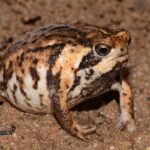The Secretive Life of Ischnocnema epipeda: A Fascinating Brazilian Rainforest Frog#
Deep within Brazil’s lush Atlantic Forest, hidden amidst streams trickling gently through dense foliage and under layers of rich, moist leaf litter, lives a tiny yet captivating amphibian—the Ischnocnema epipeda. A species scarcely known beyond specialized circles, this small, cryptically colored frog embodies the spirit of quiet perseverance and ecological harmony, silently narrating the tale of survival and adaptation in one of the world’s richest yet most imperiled ecosystems. Far from being just another obscure frog, Ischnocnema epipeda offers invaluable insights for ecologists and curious nature enthusiasts alike, showcasing the interconnectedness of tropical rainforest biodiversity.
Join us as we step delicately into their leafy home, unveil the intricate details defining their existence, and capture a glimpse into the subtle marvels of their hidden lives.
Taxonomy and Classification#
Scientifically classified under the family Brachycephalidae, this particular frog proudly carries the distinctive nomenclature Ischnocnema epipeda. The genus Ischnocnema contains a variety of small terrestrial frogs widespread in South America, particularly in Brazilian territories. This genus, characterized by direct development—meaning they bypass the full aquatic tadpole phase—speaks volumes about adaptation and evolution in challenging terrestrial environments.
Initially described in 1976, the species name “epipeda” itself hints toward its terrestrial affinities, reflecting a morphologically streamlined design well-adapted for life on the forest floor.
Natural Habitat#
Geographic Range and Distribution#
The Ischnocnema epipeda calls the wondrous Atlantic Forest biome home, centered in southeastern Brazil’s coastal regions. This vast, biodiverse area, famous for its exceptional variety of fauna and flora, offers an ideal habitat for this species. Primarily concentrated in subtropical and tropical moist lowland and montane forests, these frogs thrive amidst canopy-shaded forest floors, tangled understory shrubs, and abundant leaf litter.
Though rarely seen due to their secretive lifestyles, their presence throughout these verdant corridors adds crucial stability to ecological food webs.
Forest Floor Preferences#
Venturing into the shadowy depths of the Atlantic Forest, one may first overlook the habitat preferred by the humble Ischnocnema epipeda. Hidden beneath fallen leaves, moist patches of moss, and decomposing logs, the humid microclimates at ground level ensure the frog’s vital hydration and constant protection from potential predators.
The humidity and near-constant temperature produced by these forests’ dense canopy creates an ideal microhabitat for terrestrial amphibians like Ischnocnema epipeda, sustaining them despite external climatic fluctuations.
Physical Characteristics#
At first glance, this species seems to embody mere subtlety itself, displaying cryptic patterns and muted colors perfect for merging with its surroundings. Adult frogs measure only around 20 to 30 millimeters, making them impressively diminutive yet perfectly sized for their secretive forest lifestyle.
Typically presenting shades of earthy browns and greens, their skin showcases stunning camouflage. Intricate dorsal patterns and variable darker markings, often mottled or speckled finely with tiny flecks, mirror the nuances of the leaves and debris amid which they hide.
Adaptations for Survival#
The subdued colors and careful markings of Ischnocnema epipeda are crucial adaptations enabling them to evade detection. Camouflage isn’t their only line of defense; their skins also contain glands emitting toxins subtle enough to deter potential predators from attempting a meal.
Moreover, these frogs display impressive muscular adapted limbs ideal for swift hopping or quiet creeping, allowing them efficient motion through dense ground cover. Their web-free digits hint at their terrestrial habits, minimizing obstacles encountered in navigating their leafy world.
Behavior and Life Cycle#
Foraging and Eating Habits#
Under the veil of nightfall, the Atlantic Forest once again awakens, its nocturnal inhabitants such as Ischnocnema epipeda beginning their nightly forays. Opportunistic predators, these frogs actively hunt small invertebrates, including insects, spiders, and mites hunting within the damp leaf litter. Their keen eyesight coupled with their precise yet swift tongues ensures effective predation upon lurking prey.
Unique Breeding and Reproductive Strategy#
Unlike many of their amphibian cousins, these frogs display a remarkable reproductive strategy described as direct development. Embryonic development takes place entirely inside eggs laid carefully in moist terrestrial niches—such as sheltered leaf litter or beneath damp logs—completely eliminating aquatic tadpole phases. These translucent eggs shelter delicate embryos until they hatch immediately as miniature frogs, perfectly formed replicas of their terrestrial parents.
This fascinating adaptation not only reduces vulnerability during the perilous aquatic stage but also allows these tiny frogs to thrive within their hidden terrestrial habitats, less dependent on standing water pools.
Ecological Role#
Despite their inconspicuous presence, Ischnocnema epipeda plays significant ecological roles within their forested ecosystem. By effectively regulating insect and small arthropod populations, they help maintain ecological balances, keeping pests under control and ensuring the health and productivity of undergrowth vegetation.
Moreover, these frogs serve as vital prey items to a variety of predators. Snakes, birds, and larger amphibians regularly hunt these tiny amphibians—making them essential components in the broader food web. Their continued presence symbolizes the health and overall integrity of their surrounding habitats, thus classifying them as indicator species signifying environmental health and stability.
Threats and Conservation Status#
Survival Challenges#
Like numerous other species residing in Brazil’s Atlantic Forest, the continued existence of Ischnocnema epipeda faces looming threats primarily linked to habitat degradation and loss. Rampant deforestation—the consequence of urbanization, agriculture expansion, logging, and infrastructural development—marks the most critical threat. Additionally, climate change-induced variability—altering rainfall, humidity, and temperature patterns—poses further strain on these frogs’ narrowly adapted physiologies and habitats.
Diseases like chytridiomycosis—a fungal infection ravaging amphibian populations worldwide—may also pose threats, though current impacts on this species remain poorly understood, warranting careful monitoring.
Current Conservation Efforts and Future Prospects#
While globally underrepresented in conservation attention, dedicated scientists and governmental entities strive relentlessly to protect habitats within parks, reserves, and protected corridors located alongside Brazil’s southeastern coast—helping safeguard small amphibians such as Ischnocnema epipeda.
The International Union for Conservation of Nature (IUCN), however, currently classifies this particular species as “Least Concern,” acknowledging its estimated stable population numbers and relatively wide distribution. Nevertheless, ongoing protection of their habitats and sustained ecological research remain imperative to ensure these frogs’ continued wellbeing.
Cultural and Scientific Significance#
While often overlooked culturally due to their elusive nature, the scientific significance of Ischnocnema epipeda cannot be overstated. Amphibians like this frog offer biologists unparalleled opportunities to study direct developmental modes, evolutionary ecology, and adaptive radiation within complex tropical ecosystems.
Furthermore, ecological researchers frequently utilize amphibians as sentinels, assessing ecological health and impacts resulting from environmental stresses. Thus, conservation and protection of species such as Ischnocnema epipeda continue to produce invaluable ecological monitoring and climate data.
Conclusion#
The enchanting tale of Ischnocnema epipeda beautifully embodies nature’s quiet miracles—showcasing ecological intricacy, evolutionary marvels, and genuine environmental interconnectedness. By delving deeper into ecosystems underpinning this incredible small amphibian, not only do we marvel at life’s resilience but, importantly, reaffirm our shared responsibility towards its preservation.
Supporting ongoing conservation efforts, cultivating knowledge about such usually undiscovered species, and advocating environmentally responsible practices ensures we pass forward the living narrative of the Atlantic Forest, a precious legacy brimming with timeless biodiversity wonders.







